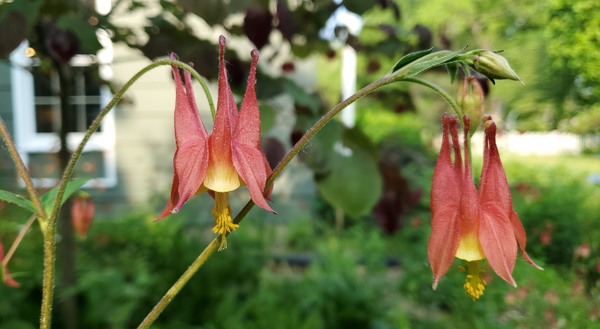
During the flowering lull of late spring in my home gardens, I often admire the unique, dangling blooms of our native wild columbine (Aquilegia canadensis). This plant occurs in nearly every county of Illinois and its native range spans the Eastern US, from Florida and Texas to Canada. It is a versatile and adaptive plant, a prolific seed producer and a wonderful addition to any pollinator garden given its interesting flowers and quirky character.
One look at a columbine flower inspires curiosity. It has several sharp points protruding upward, several dangling structures hanging down, and a wonderful progression of color, from pinkish-red near the upper points to the bright yellow color of its dangling stamens (male flower parts) . It is a unique flower structure to say the least, adding ecological and ornamental interest to any garden space.
The flower consists of a combination of 5 petals and 5 petal-like sepals that protrude outward. The petals themselves create 5 upward pointing tips on each flower, which are actually long nectar spurs. These spurs are outgrowths of the petal that house the flower’s nectaries, or nectar-producing plant parts. Insect visitors in seek of nectar typically must crawl up inside the flower to access this food source or possess long enough mouthparts to reach the nectaries from afar.
While accessing nectar, insects are forced to contact the dangling pollen-producing structures (stamens) which are interspersed with female flower structures (called pistils). In visits to subsequent flowers, pollen is spread from plant to plant as the insects contact the flower’s reproductive parts.
What Might Use Wild Columbine?
Bumblebees (Bombus spp.), sweat bees (Lasioglossum spp.) and ruby-throated hummingbirds (Archilochus colubris) are the primary nectar-seeking visitors of these flowers. Hummingbirds are known for their preference toward red flowers with long tubes, using their specialized mouthparts to access nectar deep within. Since they can hover, they easily gain access to the hanging flowers of columbine.
Bumblebees access nectar but are also noted to collect pollen to support their larvae since the draping pollen structures are ripe for the plucking. The pollen harvest also facilitates pollination as the bees perform their tasks across all the dangling plant parts.
The rusty patched bumble bee (Bombus affinis), has been observed to bypass the pollen scene altogether and directly access nectar by perforating the upper nectar spur and inserting their tongues for the sweet reward. This bee is the only bumblebee observed to perform “nectar robbing” on columbine, but other bee species are known for this kind of nectarial larceny on other plant species. The behavior is considered robbery because these ingenuitive insects avoid the stamens to directly access nectar, thus exploiting the typically mutualistic plant-pollinator relationship.
Wild Columbine in the Landscape
In the landscape, columbine can provide over a month of colorful blooms. Plus, it offers interesting foliage as the flowers fade to display the three-lobed, compound leaves. If flower stems are cut after full development the bloom period can be extended longer. While columbine can spread by rhizomes, it is rare, and the plant primarily spreads by seeds. It can sometimes be a weak perennial, popping up for a few years and fading away. However, it’s a sure bet that one of its seedlings will persist somewhere in the garden. Its self-seeding nature can be described by some as a nuisance, but I have always appreciated the free plants and the interesting places in the garden where they emerge. If they happen to pop up in an unwanted spot, they’re easy enough to pull.
Columbine prefers part shade and can even thrive in full shade. It can also handle full sun, given adequate soil moisture, making it a versatile plant and allowing its seedlings to flourish in a variety of locations.
I think columbine works best as a self-selecting mass planting. In my garden, we have a nice patch that has slowly spread from just a few initial plants, installed 4 or 5 years ago. We’ve allowed it to spread and self-select the best location for optimal growth by keeping the areas with the denser columbine coverage and weeding it out of areas it is weakly spreading to favor other plants. The resulting patch is now thriving to create quite the effect this time of year as hummingbirds buzz amongst all the swaying blooms.